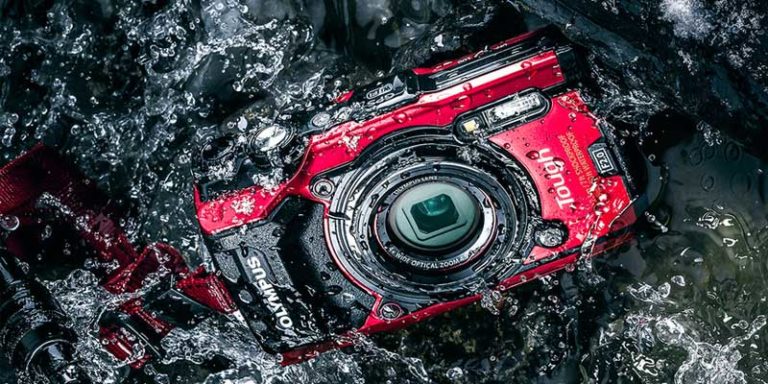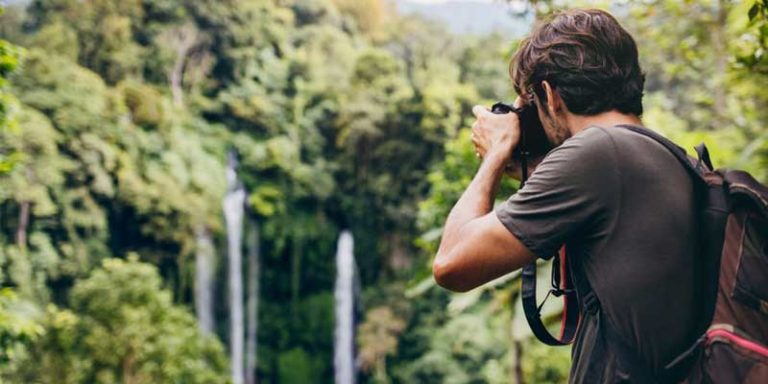Advertisements have taken over our minds. We have been lead to believe that we can’t have the best results without the flagships. Wildlife photography is one of those areas. We all have been programmed to think that without the $2000 flagship camera, our photographs will suck! We simply don’t believe in the fact that affordable cameras exist, and in this world!
There are many affordable options in the market that can get you started without burning through your wallet. The complex options offered by a flagship can be distracting and confusing, especially for beginners. So some people like the simple user interface with an affordable price tag. Yet, they will get the job done. The results will be somewhat close to a flagship but with half or even less the price in some cases.
Following are the best cameras for wildlife photography if you’re on a tight budget:
1. Nikon D3500

Nikon D3500 is the latest entry-level and budget-friendly camera. This camera replaces the very successful Nikon D3400. Now on paper, this camera looks to be very similar to the one it’s replacing. The sensor, processor, ISO range, autofocus, and LCD are exactly the same. But there’re some improvements. The camera is smaller, lighter, and the battery performance is much better than the D3400. The biggest change with this camera is in the design, layout and the grip. Compared to other Nikon cameras, the grip is very comfortable. All the key buttons are now placed to the right of the LCD screen. Nikon claims that this makes it easier to change the settings using just one hand.
This camera has a continues burst mode of up to 5 frames/s. It’s the same as found in the D3400 and that’s quite a bit. It has an 11 point autofocus system, there’s nothing overly special about that it’s low but it really depends on what you’re doing with that.
D3500 takes videos at 1080p up to 60 fps. That’s the upper limit and you can scale back that as well.
The Nikon also removed the AA filter. The AA filter is the anti-aliasing filter. It is also known as the low pass filter. It tends to soften images when it’s in the camera. A lot of entry-level cameras have the AA filter and Nikon removed it.
Key Features:
- Pixels: 24.2 Megapixels
- Maximum Resolution: 6000 x 4000
- ISO: Auto, 100 to 25600
- Video: Full HD (1920 x 1080)
- Audio Recording: Built-In Microphone (Mono)
- Built-in Flash: Yes
- Memory Card Slot: 1 x SD/SDHC/SDXC
- Connectivity: HDMI C (Mini), USB 2.0 Micro-B, Bluetooth
- Battery: Lithium-Ion 1230 mAh
- Dimensions: 4.9 x 3.8 x 2.7″
- Weight: 12.88 oz
Pros: Lightweight compared to D3400, battery performance increased up to 30%, buttons moved the right so it is easy to use with just one hand.
Cons: Nikon dropped the infrared sensor. So you’ll not be able to use the wireless remote. Other cons include: No touch-screen feature, the function button on the front has been removed.
2. Olympus OM-D E-M1 II

Olympus OM-D EM1 II is the company’s high-end mirrorless camera. The camera features a 20.4 megapixel MOS sensor with TruePic VIII engine. The dual FAST autofocus system is combined with contrast detection and 121 on-chip phase detection points.
The E-M1 II also has a built-in 5 axis image stabilization and a large electronic viewfinder. The powerful dual quad-core processors allow for a whopping 60 fps burst mode shooting with single autofocus and 18 fps with continuous autofocus. The camera also features a super-fast image playback and one of the most advanced AF systems.
The E-M1 II is also capable of recording UHD and DCI 4K videos at 30 and 24 fps respectively. It features a 3” articulated touchscreen and a USB Type-C port. Olympus offers a lot of accessories with the E-M1 II. The most popular being the HLD-9 battery grip which doubles the battery life, two custom buttons, and two control dials and also a DC-in jack.
Key Features:
- Pixels: 20.4 Megapixels
- Maximum Resolution: 5184 x 3888
- ISO: Auto, 200 to 6400 (Extended: 64 to 25600)
- Video: DCI 4K (4096 x 2160)
- Audio Recording: Built-In Microphone (Stereo), External Microphone Input
- Built-in Flash: None
- Memory Card Slot: 1 x SD/SDHC/SDXC
- Connectivity: 5mm Headphone & Microphone, 2.5mm Sub-Mini, HDMI D (Micro), USB 3.0, Wi-Fi
- Battery: BLH-1 Lithium-Ion
- Dimensions: 5.3 x 3.6 x 2.7″
- Weight: 1.26 lb
Pros: Solid and weather sealed body which is great for outdoors. Mic & headphone jacks, fully articulating LCD
Cons: Only 1 SD slot is UHS-II, a little expensive
See the Olympus OM-D E-M1 Mark II
3. Canon EOS M6

What makes the Canon EOS M6 so favorable for outdoor photography is its portable and lightweight design that makes it easy to carry. The M6 belongs to Canon’s M-lineup sitting between the M3 and the M5. It is sold with a 15-45mm and 18-150mm lenses as kit options.
The M6 is a 24MP APS-C mirrorless digital camera with twin dial controls and a touch screen interface. The sensor of the M6 is designed to work with Canon’s Dual Pixel CMOS Autofocus Technology. This allows for full-time phase-detect autofocus for fast focusing and nice and smooth video recording. The sensor also works with Canon’s DIGI 7 engine for better subject detection and tracking.
The camera allows for 7 fps continuous shooting (9 fps with focus and exposure locked) and 1080p@60fps videos recording. The other two most prominent features of the M6, the five-axis image stabilization and a screen that can be flipped up to face the front, make it appealing to vloggers. Other features include wifi and raw file processing. The camera lacks an electronic viewfinder.
Key Features:
- Pixels: 24.2 Megapixels
- Maximum Resolution: 6000 x 4000
- ISO: Auto, 100 to 6400 (Extended: 100 to 25600)
- Video: Full HD (1920 x 1080)
- Audio Recording: Built-In Microphone (Stereo), External Microphone Input
- Built-in Flash: Yes
- Memory Card Slot: 1 x SD/SDHC/SDXC
- Connectivity: HDMI D (Micro), USB 2.0 Micro-B, Wi-Fi, Bluetooth
- Battery: Lithium-Ion 1040 mAh
- Dimensions: 4.4 x 2.7 x 1.8″
- Weight: 13.76 oz
Pros: It’s small enough for good traveling and not be obnoxious if you’re walking around with it on your neck.
Cons: When you attach the mic, you can’t flip the screen and see yourself for ‘selfie-mode,’ because the mic blocks it on top.
4. Panasonic LUMIX GH5

The Panasonic LUMIX GH5 is the fifth in the company’s videos and still ‘hybrid’ lineup. It features a 20MP Four Thirds sensor. The target audience of the GH5 is indie filmmakers and photographers also in touch with motion picture with its deep video-centric features.
The GH5 has 5-axis built-in image stabilization and the latest DFD AF system for faster and more decisive focus. The updated noise reduction distinguishes very well between noise and detail. The GH5 offers 9 fps continuous shooting. The camera also offers 4K and 6K photo modes of up to 30 and 60 fps respectively.
It also offers a 6K video-derived shooting mode to record short videos and pick the best shot. However, 6K doesn’t capture photos with the same number of pixels so 6K might not be what you expect. GH5 can record 4K videos. It can record 1080p videos at up to 180p and 7.5x slow motion.
Key Features:
- Pixels: 20.3 Megapixels
- Maximum Resolution: 5184 x 3888
- ISO: Auto, 200 to 25600 (Extended: 100 to 25600)
- Video: DCI 4K (4096 x 2160)
- Audio Recording: Built-In Microphone (Stereo), External Microphone Input
- Built-in Flash: None
- Memory Card Slot: 2 x SD/SDHC/SDXC
- Connectivity: 3.5mm Headphone & Microphone, 2.5mm Sub-Mini, HDMI A, USB 3.0, Wi-Fi, Bluetooth
- Battery: Lithium-Ion 1860 mAh
- Dimensions: 5.5 x 3.9 x 3.4″
- Weight: 1.59 lb
Pros: 2 SD card slots, great ergonomics, great battery life, massive lens selection (Lumix, Olympus, and Adapted Lens)
Cons: Not great in low-light, Log Profile must be purchased separately.
5. Sony DSC-RX10M II

The Sony Cybershot DSC-RX10M II is the follow up of the original RX10 and shares the same magnesium alloy, twin-dial body design, and the 24-200mm F2.8 equivalent lens. The sensor is a 1” type 20MP CMOS sensor. The sensor has a stacked design and which Sony terms as the Exmor RS, the next generation of CMOS technology.
The Exmor RS sensor comes with embedded signal processing and DRAM which helps with processing all the information coming from it. This eliminates the bottleneck caused by the external buses and provides exceptional speed. It also allows for 14 fps continuous shooting and videos modes operating at higher frame rates.
The new viewfinder is an XGA OLED 2.3M dot over 1.44M of its predecessor. The RX10M II is capable of recording 4K videos with an incredible frame rate of 240, 480 and 960. The video timing is limited on the higher frames though. It also has a built-in Wifi and NFC.
Key Features:
- Pixels: 20.2 Megapixels
- Maximum Resolution: 5472 x 3648
- ISO: Auto, 100 to 12800 (Extended Mode:64 to 25600)
- Video: 3840 x 2160p
- Audio Recording: Built-In Mic: With Video (Stereo), Optional External Mic: With Video (Stereo)
- Built-in Flash: Yes
- Memory Card Slot: microSD
- Connectivity: DC Input, HDMI D (Micro), USB 2.0, Wi-Fi
- Battery: Lithium-Ion 1080 mAh
- Dimensions: 5.1 x 3.5 x 4.0″
- Weight: 1.79 lb
Pros: Lightweight, well-built, full range of shooting options available for the advanced photographer
Cons: No external battery charger. The battery life is not very good. It’s always good to keep at least one spare battery
6. Nikon D3300

Announced in 2014 at the Consumer Electronics Show, Nikon D3300 is one of the most popular entry-level DSLR. It replaces the D3200 and represents the next generation of Nikon’s entry-level DSLR line. The reason for its popularity is because people find it to be very user-friendly.
The D3300 comes with a 24MP F3.5-5.6 18-55mm collapsible VR II lens, the same as in the D5300. Although it can’t shoot 4k videos, the 24MP APS-C sensor is one of the most powerful sensors on the market. You can shoot 5 fps continuous photos and get an extra frame in burst mode as well as the ability to shoot 1080p@60fps videos.
The Expeed 4 processor is an improvement over the D3200. The battery performance is also better than the D5300 although both use the same battery type. The reason is the lack of Wi-Fi and GPS in 3300. The D3300 has been replaced by the D3400 but that doesn’t make it a bad choice.
Key Features:
- Pixels: 24.2 Megapixels
- Maximum Resolution: 6000 x 4000
- ISO: 100 to 12,800
- Video: Full HD 1920 x 1080 / 60 fps
- Audio Recording: Built-In Mic: Optional external stereo mini-pin jack (3.5mm diameter)
- Built-in Flash: Yes
- Memory Card Slot: 1 x SD
- Connectivity: USB 2.0, Wi-Fi
- Battery: Lithium-Ion
- Dimensions: 4.9 x 3.9 x 3″
- Weight: 14.5 oz
Pros: The quality of the photos is amazing, the battery life exceptional, and it’s very easy to use.
Cons: Controls are a bit clumsy especially when changing from still shots to video.
7. Nikon D7200

If you are looking to upgrade from an entry-level DSLR, the D7200 is a choice worth considering. It replaces the D7100 and improves over it in many ways like a larger buffer, improved autofocus performance in low light, NFC and GPS and 15% better battery life.
The D7200 comes with a 24.2MP sensor, a small improvement over the 24.1MP of D7100. The D7200 is Nikon’s high-end APS-C camera. It is also the only DX-format camera currently in the lineup to support autofocus and screw drive lenses. You get 6 fps continuous shots (7 fps in 1.3x crop mode). The real highlight of the D7200 is its improved autofocus system which is far better than the D7100.
The other improved feature is the buffer size that can be noticed during continuous shooting. The buffer of the D7100 was very small and filled up instantly which affected burst shooting and bracketing as well. D7200 also has a magnesium alloy weather-sealed body.
Key Features:
- Pixels: 24.2 Megapixels
- Maximum Resolution: 6000 x 4000
- ISO: Auto, 100 to 25600 (Extended: 51200 to 102400)
- Video: Full HD (1920 x 1080)
- Audio Recording: Built-In Microphone (Stereo), External Microphone Input
- Built-in Flash: Yes
- Memory Card Slot: 2 x SD/SDHC/SDXC
- Connectivity: 5mm Headphone, 3.5mm Microphone, HDMI C (Mini), USB 2.0, Wi-Fi
- Battery: Lithium-Ion 1900 mAh
- Dimensions: 5.3 x 4.2 x 3.0″
- Weight: 1.49 lb
Pros: 2 SD card slots, great photo quality, doesn’t look like a cheap camera
Cons: The LCD is fixed, no tilt, doesn’t support 4K video shooting
8. Pentax K-3 II

The Pentax K-3 II is a successor to the Pentax K-3, a great camera in itself. The replacement of a flash with a GPS and an electronic compass conveys a clear message who the Pentax K-3 II is intended for. Thanks to its special 92 seal system throughout the body, which makes it dust, cold and waterproof, the message becomes even louder.
The camera has a 24MP APS-C sensor with an anti-aliasing simulator instead of an anti-aliasing filter. The Pixel Shift Resolution Technology lets you take high-resolution images with accurate color reproduction, finer details, and less noise. You can shoot 8.3 fps continuously and record 1080p@60fps videos.
The camera also has an improved shake reduction system, improved autofocus that works down to -3EV, faster autofocus with newer lenses and much more. The camera has a rugged body made of magnesium alloy and a stainless steel frame. So if you are looking for a camera to shoot wildlife in a humane manner, then this is a good consideration.
Key Features:
- Pixels: 24 Megapixels
- Maximum Resolution: 6016 x 4000
- ISO: Auto, 100 – 51200
- Video: Full HD (1920 x 1080)
- Audio Recording: Mono
- Built-in Flash: No
- Memory Card Slot: 2 x SD/SDHC/SDXC
- Connectivity: USB 3.0, HDMI
- Battery: Lithium-Ion D-LI90
- Dimensions: 5.16 x 3.94 x 3.03″
- Weight: 1.76 lb
Pros: Good dynamic range and detail, unusual feature set
Cons: No Wi-Fi or NFC, a little heavy
9. Sony Alpha SLT-A99V

The Sony Alpha SLT-A99V replaces the A900 from Sony’s remarkable Alpha series. It is a flagship model and the company’s first full-frame DSLR. The camera comes with a 24.3-megapixel CMOS sensor. The camera offers an SLT design with an electronic viewfinder instead of an optical one.
The CMOS sensor features on sensor phase-detection creating a dual autofocus system which promises focus tracking and focuses precision. The built-in image stabilization works with all sensors. The camera is capable of 6 fps continuous shooting and 10 fps in Tele-zoom mode.
The A99V can record 1080p@60fps videos. Other than that, it offers a lot of features for videos shooters as well including a silent control dial focus peaking. The camera also features mic and headphone sockets. Other features include built-in GPS, weatherproof magnesium alloy body and a lot of fancy electronics.
Key Features:
- Pixels: 24.3 Megapixels
- Maximum Resolution: 6000 x 4000
- ISO: Auto, 100-25,600
- Video: Full HD (1920 x 1080)
- Audio Recording: Stereo
- Built-in Flash: No
- Memory Card Slot: SD/SDHC/SDXC
- Connectivity: HDMI C (Mini), USB 2.0
- Battery: Lithium-Ion NP-FM500H
- Dimensions: 5.79 x 4.37 x 3.07″
- Weight: 1.79 lb
Pros: Well-constructed and well-designed body, solid performance, and a great feature set
Cons: Lack of CompactFlash, poor battery life
10. Canon EOS Rebel T5i

The Canon EOS Rebel T5i replaces Canon’s short-lived T4i. However, it is almost identical in terms of design, operations, and specifications. It also uses the same battery and accessories. The T5i is an addition to the Rebel series aimed at beginner photographers.
The T5i features an 18MP APS-C ‘Hybrid CMOS’ sensor with phase detection 9 point AF system which is conventional but uses 9 cross-type focus points and additional accuracy at the center with faster lenses. The camera has a touchscreen that is of capacitive type instead of pressure type and works like a smartphone. The screen also supports multi-touch and gestures.
The 14-bit DIGIC 5 processor allows 5 fps continuous shooting. The processor allows a maximum ISO of 12,800 (25,600 extended) and lens specific correction from chromatic aberration and vignetting. The AF is continuous in movie mode with subject tracking. The JPEGs can be processed in the camera.
Key Features:
- Pixels: 18 Megapixels
- Maximum Resolution: 5184 x 3456
- ISO: Auto, 100 to 12800 (Extended: 100 to 25600)
- Video: Full HD (1920 x 1080)
- Audio Recording: External Microphone Input
- Built-in Flash: Yes
- Memory Card Slot: SD/SDHC/SDXC
- Connectivity: HDMI C (Mini), USB 2.0
- Battery: LP-E8 Lithium-Ion
- Dimensions: 5.2 x 3.9 x 3.1″
- Weight: 18.52 oz
Pros: Comprehensive feature set, responsive vari-angle touchscreen
Cons: No new sensor, LCD attracts fingerprints, no Wi-Fi
11. Nikon D5300

Nikon D5300 is termed as the ‘advanced beginner’ DSLR and replaces the D5200. It is almost identical to its predecessor in ergonomics and design. It features a 24MP APS-C sensor similar to that of the D3300. The sensor lacks an anti-aliasing filter that gives it an edge over the D5200 in terms of resolution.
The battery of the D5300 is also an improvement over that of the D5200 and now gives 600 shots of battery life instead of 500 as in the D5200. However, the battery life does not account for the Wi-Fi and GPS. Yes, it has built-in Wi-Fi and GPS. The camera offers 5fps continuous shooting and 1080p@60fps video recording.
The D5300, however, lacks a touchscreen and also a twin-dial. Both of these features are offered by Nikon in their more expensive versions. But their competitors are offering these features in this price range.
Key Features:
- Pixels: 24 Megapixels
- Maximum Resolution: 6000 x 4000
- ISO: Auto, 100 to 12800 (Extended: 100 to 25600)
- Video: Full HD (1920 x 1080)
- Audio Recording: Stereo
- Built-in Flash: Yes
- Memory Card Slot: SD/SDHC/SDXC
- Connectivity: HDMI C (Mini), USB 2.0, Microphone port
- Battery: Lithium-Ion EN-EL14a or EN-EL14
- Dimensions: 4.92 x 3.86 x 2.99″
- Weight: 16.93 oz
Pros: EXPEED 4 processor, great performing sensor, no anti-aliasing filter, High-res vari-angle screen
Cons: No touchscreen, mainly on-screen control, Special Effects are JPEG only
Best Affordable Cameras for Wildlife Photography: Comparison Table
| Camera | Pixels | Video | Dimensions | Weight |
|---|---|---|---|---|
| Nikon D3500 | 24.2 MP | Full HD (1920 x 1080) | 4.9 x 3.8 x 2.7″ | 12.88 oz |
| Olympus OM-D E-M1 II | 20.4 MP | DCI 4K (4096 x 2160) | 5.3 x 3.6 x 2.7″ | 1.26 lb |
| Canon EOS M6 | 24.2 MP | Full HD (1920 x 1080) | 4.4 x 2.7 x 1.8″ | 13.76 oz |
| Panasonic LUMIX GH5 | 20.3 MP | DCI 4K (4096 x 2160) | 5.5 x 3.9 x 3.4″ | 1.59 lb |
| Sony DSC-RX10M II | 20.2 MP | 3840 x 2160p | 5.1 x 3.5 x 4.0″ | 1.79 lb |
| Nikon D3300 | 24.2 MP | Full HD (1920 x 1080) | 4.9 x 3.9 x 3″ | 14.5 oz |
| Nikon D7200 | 24.2 MP | Full HD (1920 x 1080) | 5.3 x 4.2 x 3.0″ | 1.49 lb |
| Pentax K-3 II | 24 MP | Full HD (1920 x 1080) | 5.2 x 3.4 x 3.0″ | 1.76 lb |
| Sony Alpha SLT-A99V | 24.3 MP | Full HD (1920 x 1080) | 5.8 x 4.4 x 3.1″ | 1.79 lb |
| Canon EOS Rebel T5i | 18 MP | Full HD (1920 x 1080) | 5.2 x 3.9 x 3.1″ | 18.52 oz |
| Nikon D5300 | 24 MP | Full HD (1920 x 1080) | 4.9 x 3.9 x 3.0″ | 16.93 oz |
How to choose a Camera for Wildlife Photography
Here are some tips to keep in mind when choosing a camera for wildlife photography. These tips are to give you a general idea and differ from person to person.
Size does matter
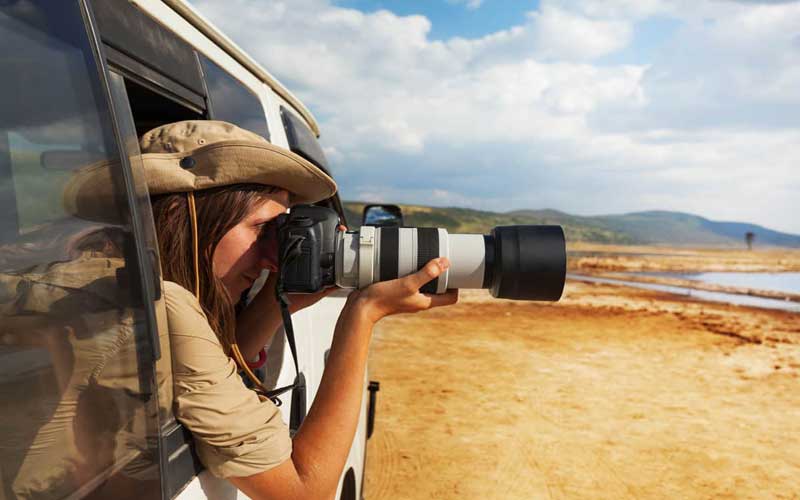
The size of your sensor is equally important as the choice of your lenses because it determines how close you get to your subject without moving. A smaller APS-C sensor works better with a lens as it provides more magnification and bumps up the standard zoom range of the lens. This means you won’t have to crop full-frame images to produce zoomed in photos of animals.
Focus is key
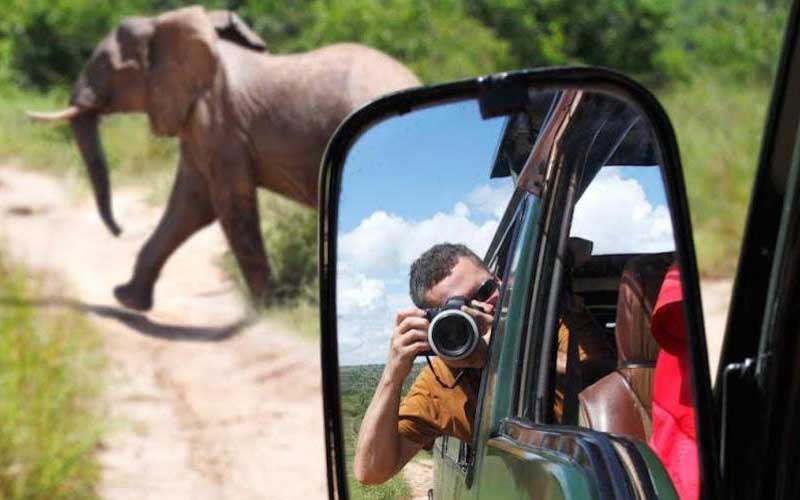
The autofocus performance of the camera is something you should always consider. Speed and accuracy are very important to take the perfect shot in the wild. Your camera should be able to focus quickly and accurately to produce sharp and clear images. Having more AF points is certainly an advantage but keep in mind that newer AF systems can still outperform the old ones. Other features to look for are focus-tracking and phase detection.
Frames in a second

How many frames can your camera capture continuously, matters when capturing fast-moving animals. Since wildlife is almost always fast moving (unless you are focusing a sloth), a higher frame rate can help you get the perfect shot. Also, keep in mind that JPEGs fill the buffer slower than raw images. You should have knowledge of how many JPEGs your camera can capture in a second. Don’t forget to use a fast memory card to keep up with your burst rates.
Low light performance
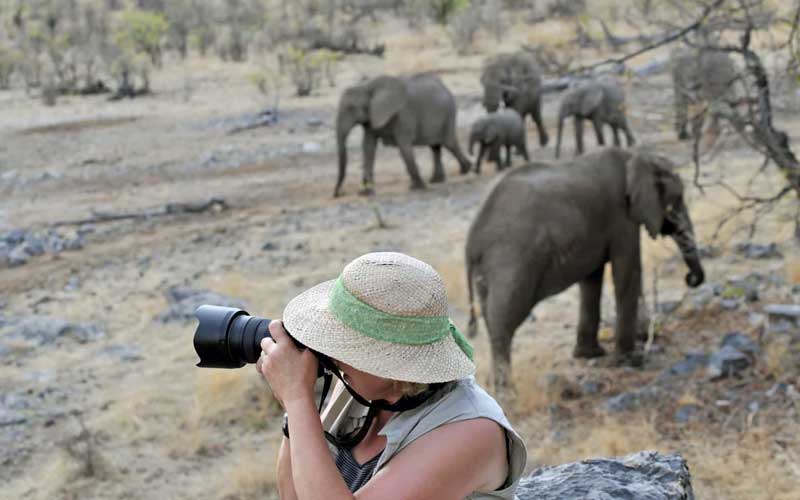
Wildlife sometimes requires you to take shots in low light conditions, especially near sunset and sunrise. It is better to consider a camera with a higher ISO range. Modern cameras are equipped with a wide ISO range so this is something you won’t usually have to worry about.
Weight and build quality
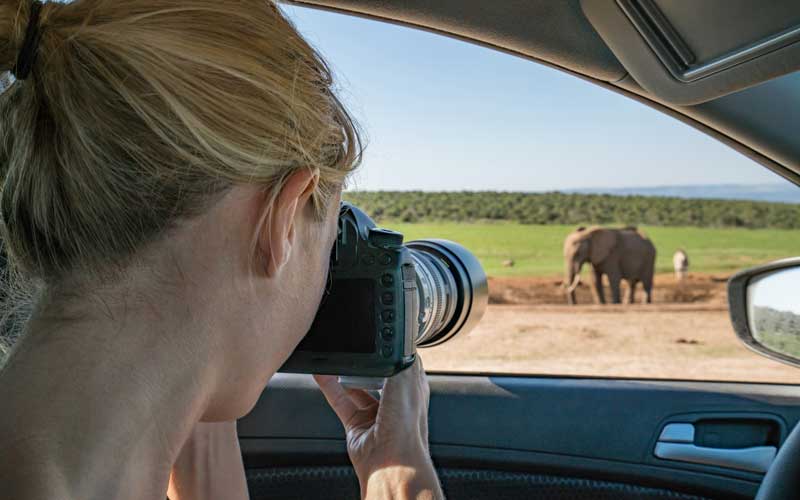
The build quality of your camera is as significant as the rest of the features of your camera. No matter how powerful your camera is, if it cannot withstand the rough outdoors, then it is useless. Make sure to go for more robust and weather sealed cameras and lenses.
For hiking and lightweight backpacking, the weight of the camera would also matter since you will be lugging it around. More powerful cameras require more hardware. This is where you would have to find a compromise between your physical limitations and that powerful hardware.

